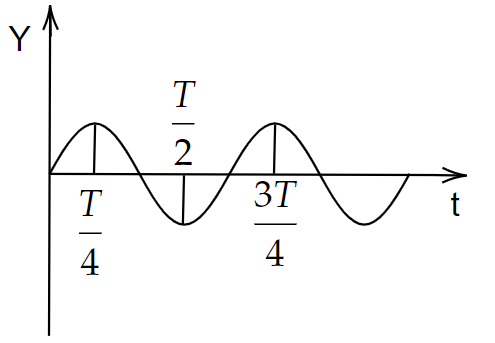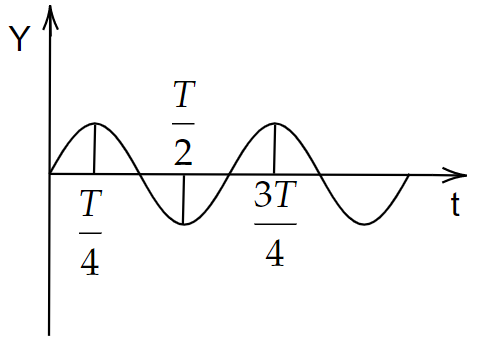
The graph shows the variation of displacement of a particle executing SHM with time. What do we infer from this graph?

A. The force is zero at the time \[\dfrac{{3T}}{4}\]
B. The velocity is maximum at the time \[\dfrac{T}{2}\]
C. The acceleration is maximum at time T
D. The P.E is equal to total energy at the time \[\dfrac{T}{2}\]
Answer
147.6k+ views
Hint: Here, we need to recall the term SHM. A simple harmonic motion is a good example of periodic motion. In simple harmonic motion, a particle will be accelerated towards a fixed point and the acceleration of the particle is proportional to the magnitude of the displacement of the particle.
Complete step by step solution:

Image: Variation of displacement of a particle executing SHM with time.
The displacement versus time graph of a simple harmonic motion is represented as shown in the figure. Here the time periods are given as \[\dfrac{T}{4}\],\[\dfrac{T}{2}\],\[\dfrac{{3T}}{4}\] and T. If we consider the first option, at \[\dfrac{T}{4}\] the force acting on the particle is zero. If we see the position of the particle at the time interval \[\dfrac{T}{4}\] is nothing but extreme.
At an extreme position, we cannot say that force becomes zero. We know that at an extreme position the acceleration becomes maximum. Similarly, the second and third options are not correct.
If we consider the fourth option, at one point\[\dfrac{T}{2}\], the potential energy is in terms of total energy. This is correct because, at this particular point, the particle is in an extreme position, that is it is having a displacement -A with this displacement whatever the velocity means it becomes zero.
So once the velocity becomes zero, kinetic energy also becomes zero, then total energy must be exhibited in some other form, that is nothing but potential energy. Therefore, at time \[\dfrac{T}{2}\] the potential energy is in terms of total energy.
Hence, option D is the correct answer.
Note: Here, in this problem it is important to remember that, when the energy of a particle is converted into potential energy and kinetic energy or at which time period it will be converted and also about the simple harmonic motion.
Complete step by step solution:

Image: Variation of displacement of a particle executing SHM with time.
The displacement versus time graph of a simple harmonic motion is represented as shown in the figure. Here the time periods are given as \[\dfrac{T}{4}\],\[\dfrac{T}{2}\],\[\dfrac{{3T}}{4}\] and T. If we consider the first option, at \[\dfrac{T}{4}\] the force acting on the particle is zero. If we see the position of the particle at the time interval \[\dfrac{T}{4}\] is nothing but extreme.
At an extreme position, we cannot say that force becomes zero. We know that at an extreme position the acceleration becomes maximum. Similarly, the second and third options are not correct.
If we consider the fourth option, at one point\[\dfrac{T}{2}\], the potential energy is in terms of total energy. This is correct because, at this particular point, the particle is in an extreme position, that is it is having a displacement -A with this displacement whatever the velocity means it becomes zero.
So once the velocity becomes zero, kinetic energy also becomes zero, then total energy must be exhibited in some other form, that is nothing but potential energy. Therefore, at time \[\dfrac{T}{2}\] the potential energy is in terms of total energy.
Hence, option D is the correct answer.
Note: Here, in this problem it is important to remember that, when the energy of a particle is converted into potential energy and kinetic energy or at which time period it will be converted and also about the simple harmonic motion.
Recently Updated Pages
How to find Oxidation Number - Important Concepts for JEE

How Electromagnetic Waves are Formed - Important Concepts for JEE

Electrical Resistance - Important Concepts and Tips for JEE

Average Atomic Mass - Important Concepts and Tips for JEE

Chemical Equation - Important Concepts and Tips for JEE

Concept of CP and CV of Gas - Important Concepts and Tips for JEE

Trending doubts
JEE Main 2025 Session 2: Application Form (Out), Exam Dates (Released), Eligibility, & More

JEE Main Exam Marking Scheme: Detailed Breakdown of Marks and Negative Marking

JEE Main 2025: Derivation of Equation of Trajectory in Physics

Electric Field Due to Uniformly Charged Ring for JEE Main 2025 - Formula and Derivation

JEE Main Participating Colleges 2024 - A Complete List of Top Colleges

Degree of Dissociation and Its Formula With Solved Example for JEE

Other Pages
JEE Advanced Marks vs Ranks 2025: Understanding Category-wise Qualifying Marks and Previous Year Cut-offs

JEE Advanced 2025: Dates, Registration, Syllabus, Eligibility Criteria and More

Units and Measurements Class 11 Notes: CBSE Physics Chapter 1

NCERT Solutions for Class 11 Physics Chapter 1 Units and Measurements

Motion in a Straight Line Class 11 Notes: CBSE Physics Chapter 2

JEE Advanced Weightage 2025 Chapter-Wise for Physics, Maths and Chemistry




